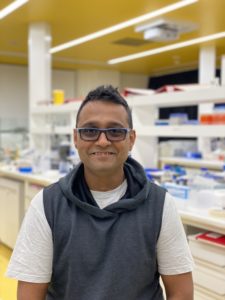Dr Rajesh Ramanathan
Senior Research Fellow and Co-Leader, NanoBiotechnology Research Laboratory (NBRL), RMIT University
Field of expertise: Materials Chemistry and Bionanotechnology
In the time you have been working in your field, what impossible things have become possible?
Point-of-care diagnostics – no one would have ever thought we will be able to detect a disease or monitor if a particular drug is working to treat a disease from the comfort of our house. Advances in the field of medical technology, nanotechnology and device fabrication have improved our ability to create easy-to-use devices for diagnosis. We have seen several examples of point-of-care devices in the market. The most prominent is the detection of glucose – to monitor diabetes. This can be done as a simple prick test where a drop of blood is used to measure the amount of glucose in the blood. We now also have devices that will monitor glucose continuously and send this information to our phone on a real-time basis. Such technologies will revolutionize medical technology and will provide care to the most vulnerable patients.
What impossible thing(s) are you working towards making possible, and why?
Humans need some sun exposure to maintain healthy levels of Vitamin D, while excessive exposure can cause sunburn and skin cancer. Australia has one of the highest incidences of skin cancer in the world, and much of this is due to exposure to solar UV. We do apply sunscreen that protects us from the harmful effects of UV, but we have no way to determine if we have been exposed to much UV exposure. Another challenge with solar UV is that a healthy amount of UV will depend on the skin type – Fair skin (Type I) can tolerate only one-fifth of the UV exposure compared to dark skin (Type VI). Knowing these challenges and with a clear practical purpose for the Australian climate, our group has created a wearable, disposable and simple to use sensing device to monitor our exposure to solar UV which can be tailored to different skin types. This device contains a spot of ink that darkens in colour when you have received your recommended dose of UV based on the colour of skin. The simplicity of the design was kept in mind to facilitate their use as materials to increase awareness around sun safety.
What is an example of an impossible thing others in your field are currently working to make possible?
Cancer is the second leading cause of death globally with about 1 in 6 deaths occurring due to cancer. This disease also has a significant economic impact which is ever increasing. The total annual economic cost of cancer in 2010 was estimated at ~ US$ 1.2 trillion. Two of the primary ways we can effectively reduce the cancer burden is (i) correct cancer diagnosis to administer effective treatment as every cancer type requires a specific treatment and (ii) early detection as many cancers have a high chance of cure if diagnosed early.
Although this is well-known, recent work in this area has been promising. Much of cancer research is focused on identifying reliable cancer biomarkers (molecules present either on the surface of the cell or released in the body) as this is the most essential step that will assist in early cancer detection and better cancer treatment. With advances in technology, researchers are creating advanced nanosensors to learn what biomarkers reveal about cancer type.
In your field are there any things that you predict will remain impossible, and why?
One particular aspect that will be the most challenging will be to detect one cell could be a pathogenic bacterium, virus, or a cancer cell, in a blood sample that will have millions of other non-specific molecules (this is like finding a needle in a haystack). This aspect has been shown in theoretical sense i.e. it is possible but experimentally, this is still elusive.
There are several challenges to overcome in this instance – (i) the sensor should have an extremely high level of sensitivity to detect one cell, (ii) the non-specific molecules in the sample can interact with your sensor – we need to find a way for these molecules to not interact with the sensor (this aspect is called biofouling); (iii) the ability to specifically identify the cell of interest (we need to find the key that will fit into the lock). Although I say this is a challenge today – we are all working towards making this impossible possible.
In your opinion what formerly impossible and now possible thing in your field has made or is making the largest contribution to human or planetary flourishing?
Comprising of several powerful computational and electronic systems, smartphones have a big impact on our lives. These devices have transformed the way we communicate and access information. Can you believe, the first smartphone was introduced by Apple in 2007. Within only thirteen years, smartphones have become an integral part of our lives with newer portable technologies further being refined with each passing year.
With over 50% of the global population having access to smartphones, their integration with healthcare has been a game-changer. For instance, access to healthcare in remote regions of the globe can often be limited. A portable, low-cost and simple way to detect diseases by having additional attachments to mobile phones can make this possible. 2 examples of this are (i) a low-cost CD4 cell counter for the detection of HIV – a detection chip (less than $2) and an optical attachment ($5) required in addition to a smartphone; (ii) TRI analyser – uses the camera and LED of a smartphone to perform spectroscopy to measure the colour absorption, colour emission, or colour reflection from assays. This tool can be applied in medical diagnostics, environmental monitoring, food safety, animal health, and many others.

